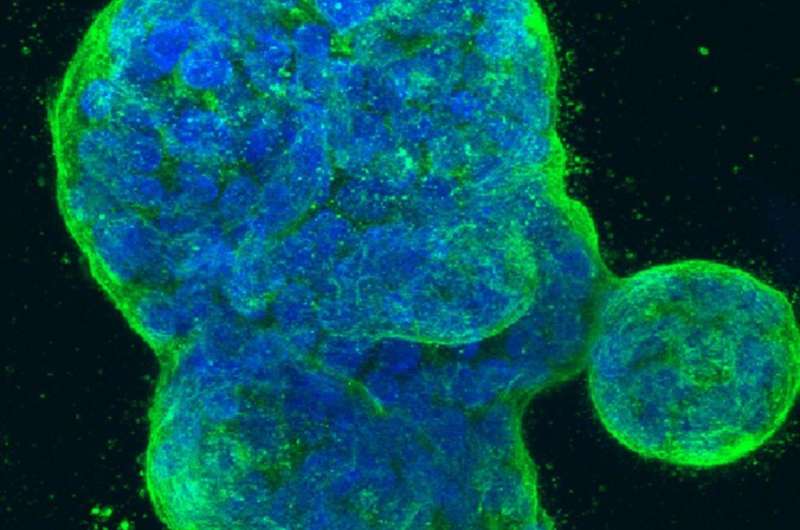As surgeons tout robot-assisted breast cancer surgeries, safety remains a question

Is doing major surgery through small incisions better for the patient than more traumatic traditional methods?
The answer is surprisingly complicated, especially for patients who have cancer—or don't realize they have cancer. Minimally invasive technology may fragment a tumor before extracting it, leaving unseen malignant cells behind to grow and spread.
Now, robot-assisted surgery—the most high-tech, high-cost version of minimally invasive technology—is being introduced for breast cancer treatment. But rigorous clinical trials have not been done to compare the safety of robotic approaches with conventional methods.
The University of Pennsylvania this month touted "the world's first" robotic double breast reconstruction using a flap of tissue from the woman's abdomen. But the robot was employed only after the patient had a conventional mastectomy, sidestepping the risk of spreading tumor cells.
This spring, the American Society of Plastic Surgeons hailed Long Island surgeons for doing the nation's "first robot-assisted, nipple-sparing double mastectomy" and implant reconstruction—in a patient who did not have cancer. She has the BRCA gene and removed her healthy breasts to prevent cancer.
Another use of the robot, trumpeted in October by the Asbury Park Press, was suspended this week pending a review by Monmouth Medical Center, according to the newspaper. Stephen Chagares, a Tinton Falls, N.J., breast surgeon, performed a robotic mastectomy on a patient with breast cancer, followed by reconstruction with an implant. (Chagares did not respond to Inquirer requests for comment.)
The hospital launched its inquiry after Hooman Noorchashm, a Philadelphia-area cardiothoracic surgeon turned patient advocate, sounded an alarm. He pointed out that oncologists strive to remove tumors in one piece to avoid leaving residual cancer. His wife, Amy Reed, an anesthesiologist and mother of their six children, died at age 44 in 2017 of a hidden uterine cancer that was spread during a hysterectomy performed with a minimally invasive tissue-slicing device called an electric morcellator.
"If you want to create a new standard of care and advertise it, at the very least you need to do a randomized controlled trial to demonstrate safety and effectiveness," Noorchashm said. "You shouldn't just advertise 'small incisions, faster recovery.' That's basically what happened with the morcellator."
In Europe, a clinical trial is underway to compare robotic and conventional mastectomy after cancer diagnosis, including five-year survival. But a separate French study of robotic mastectomy has no comparison group—considered vital for a definitive study—and aims to assess complications and cosmetic results, not recurrence rates or survival.
If history is any guide, clinical trials can disprove assumptions about the benefits of "laparoscopy—using instruments and lighted scopes inserted through keyhole incisions—or the da Vinci robot, a system made by Intuitive Surgical that costs up to $2 million.
For example, many prostate cancer surgeons once believed robotic surgery reduced urinary and sexual side effects. But a rigorous trial found the rates were no better than with conventional open surgery.
Just last month, trial results showed that laparoscopic hysterectomies to treat cervical cancer reduced survival compared to traditional abdominal hysterectomies. That unexpected finding came a decade after the less invasive approach was embraced as a way to speed recovery and reduce complications.
There is disagreement about whether minimally invasive techniques should be subjected to a clinical trial before being used for breast reconstruction or preventive mastectomy.
At Penn, plastic surgeon Suhail Kanchwala said he and colleagues have done about 170 laparoscopic tissue flap breast reconstructions. He said the approach involves less cutting of abdominal tissue and less pain, so patients don't need narcotic painkillers. Adding the robot gave the surgeons even greater precision and dexterity.
"The critical difference is that this is not the same as cancer surgery," Kanchwala said. "This is about reconstruction. The outcomes are pretty easy to measure."
However, he said, Penn is now planning a clinical trial comparing robotic vs. conventional mastectomy to remove healthy breasts of BRCA gene patients.
Neil Tanna, the plastic surgeon who led just such a robotic surgery at Long Island Jewish Medical Center, sees cancer prevention as a clear-cut indication.
"There's going to be some controversy, but no one can fault us for doing robotic surgery for prophylactic (preventive) reasons," he said.
But Tanna said the role of the robot in removing cancerous breasts does warrant a high-quality trial to assess safety and effectiveness. Northwell Health, a network that includes Long Island Jewish Medical Center, has been working with Intuitive Surgical and the U.S. Food and Drug Administration to design such a trial, Tanna said.
"We owe it to science, to our patients and to ourselves," he said.
©2018 Philly.com
Distributed by Tribune Content Agency, LLC.















